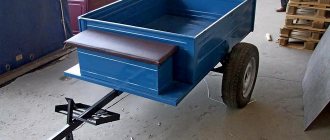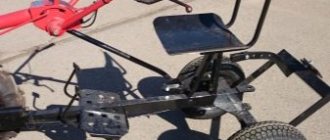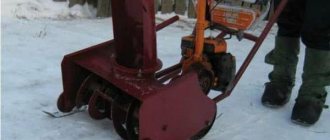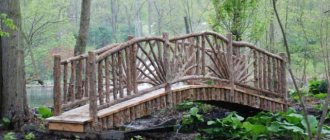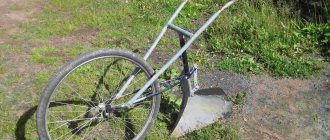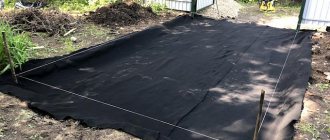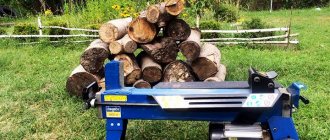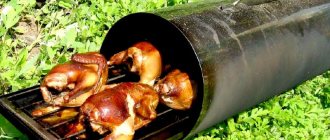Owners of walk-behind tractors are increasingly resorting to all sorts of home-made production of various components for this unit.
As a result, we get do-it-yourself attachments, transforming the walk-behind tractor into a more powerful one by installing a new engine, as well as many different modifications and additions.
Of course, all this is not due to a good life, because most owners of a walk-behind tractor strive not only to save on its purchase, but also to reduce the costs of its further operation.
In particular, many want to make homemade tracks for walk-behind tractors, thereby wanting to improve the cross-country ability of their units.
The resulting walk-behind tractor on tracks will perform a slightly different role in a person’s personal household, because it is already becoming a full-fledged vehicle, somewhat reminiscent of a caterpillar tractor.
Accordingly, a much wider scope of work opens up before him, which largely justifies this kind of independent alteration.
About the device
Tracked walk-behind tractors are much less common than their wheeled counterparts. The explanation for this is quite clear - wheeled walk-behind tractors Cayman, Patriot, Texas, Foreman, Crosser, Viking, Forza are more suitable for plowing land, i.e. its design is most suitable for working on the ground.
Thus, all conversions of a wheeled walk-behind tractor into a tracked walk-behind tractor involve the additional attachment of one wheel on each side. As a result, we get a 4-wheeled walk-behind tractor, on which you can already put on tracks (homemade or store-bought, for example, Buran caterpillar).
Additional wheels
By the way, additional wheels can be made removable so that you can quickly turn it back into a standard walk-behind tractor for working in the garden. This can be achieved by attaching these wheels to an axle that we already have in stock, through a flexible or rigid transmission.
This solution is the most appropriate, because there is no need to weld additional fasteners.
As for the design of such walk-behind tractors, they are completely identical to wheeled walk-behind tractors:
- Engine. Tracked models use a more powerful 4-stroke engine, which has an axle locking function.
This is important because it allows the crawler to turn in place without making a full circle to turn.
- Transmission. Gearbox, gearbox and clutch system - this standard set is also included in the design of tracked walk-behind tractors.
- Chassis. Here, in principle, everything is clear from the name - the design uses tracks instead of a wheelbase. As already mentioned, in the case of alteration, one roll is added to the existing pair of wheels on each side, on which a homemade caterpillar is already put on.
- Controls. They are located on the control handle, including various clutch levers, emergency engine stop, etc.
Before we begin to describe the method of making tracks yourself, it would not hurt to evaluate the offer of some special stores that sell walk-behind tractors and related materials. In particular, we will estimate the cost of some types of tracks for well-known walk-behind tractors.
Caterpillars for the Neva walk-behind tractor
Snowmobile attachments for the Neva walk-behind tractor
Thus, the tracks for the Neva walk-behind tractor, the price of which is about 28 thousand rubles, is a full-fledged snowmobile attachment. Seats for drivers can be purchased separately, thanks to which the Neva walk-behind tractor becomes similar to a mini tracked tractor, albeit with lower performance indicators.
Technical data:
- developed speed (with Neva walk-behind tractor) – about 18 km/h;
- total weight of the console – 37 kg;
- length – 100 cm;
- width – 60 cm;
- height – 34 cm;
- number of passengers – one driver and one passenger.
For more information about the caterpillar drive for the Neva walk-behind tractor, watch the video:
In addition, an attachment to a walk-behind tractor on tracks is available for sale, designed for attachment to the Agat and Salyut models. Its cost is 25-27 thousand rubles. This design does not have the ability to attach a driver's seat, which somewhat limits the capabilities of this device.
However, it is quite suitable for off-road and snowy driving. Snowmobile attachments on tracks for walk-behind tractors are quite common, as evidenced by a fairly large number of different models in online stores.
Their distinctive feature is the ability to control them not only with two hands, following the walk-behind tractor, but also while sitting in a folding sled, which, however, must be purchased separately.
Considering that the average price for such attachments is about 30 thousand rubles (plus the price of folding sleds is about 5 thousand rubles), we can say that making tracks yourself is a fairly optimal solution for those who do not have the opportunity to spend extra money on purchasing .
Top popular walk-behind tractor models on tracks
Tracked walk-behind tractors are a rarity; in most cases, manufacturers produce gooseneck attachments that can be installed on wheeled models. Most often, there are specialized snow-removing walk-behind tractors on tracks.
- Caiman Vario is one of the most famous crawler walk-behind tractors. The machine consists of a standard walk-behind tractor on Caiman Vario 70S pneumatic wheels with a Japanese 7 hp engine, removable tracks and a two-seater sled. In this winter configuration, it can be used as a snowmobile for fishing or hunting trips. For work related to the transportation of goods over rough terrain, the walk-behind tractor is equipped with cargo sleds and weights. To remove snow, you can install a shovel blade or a snow removal attachment.
- Yard-Man YM 7110 DET – snow plow walk-behind tractor with a 10 hp 4-stroke engine. Working width – 710 mm, working height – 530 mm, snow throw range – up to 15 m. 8-speed drive (6 forward, 2 reverse) with friction clutch and tracks with directional tread guarantee high performance even in difficult areas.
- HUTER 8100C is a self-propelled snow blower equipped with a four-stroke single-cylinder 11 hp engine, designed for effective clearing of snow drifts in emergency winter conditions. The snow blower's chute covers a snowdrift of 700 mm in width and 540 mm in height. The power plant of the unit is equipped with an electric starter, heated handles and an autonomous fuel supply.
Do you use a crawler walk-behind tractor for snow removal, cross-country driving, winter fishing or hunting?
Necessary materials
As mentioned earlier, to transform the wheeled walk-behind tractors Sadko, Don, Huter, Profi, Plowman, Champion, Carver, Husqvarna into a tracked walk-behind tractor, you will need a fairly powerful engine with axial locking.
Power is important because such a walk-behind tractor will be used on a fairly complex surface, the maneuverability of which requires additional technical data.
Track materials
To summarize a little, we can highlight the main materials that we will need:
- The presence of the walk-behind tractor itself with a gearbox with a powerful 4-stroke engine with axle locking.
- A couple of extra wheels so you can pull the track on them.
- The homemade caterpillar itself, made from available materials.
- Depending on what material will be used in production, we may need two large car tires or transport tape.
Using these materials, you can make a fully functional crawler walk-behind tractor.
At the same time, you can make a full-fledged mini tractor on tracks if you add an additional cargo platform, or use it as an all-terrain vehicle in the snow by adding a platform on skids. In general, there is complete scope for imagination.
From belts and chains
Another method of making a track involves using standard V-belts and chains.
- To make a caterpillar from the belts, they must be connected to each other by lugs (tracks) using bolts or rivets.
- To create a goose from chains, you need to take two pieces of chain of the same length. Unclench the end links of both segments and connect the chains so that you get two closed rings. Next, the loosened links are clamped and welded for strength.
You can watch the video on how to make tracks for a walk-behind tractor with your own hands:
Next, metal lugs (tracks) of the required thickness are manufactured. Instead of steel, you can use another material (wood, plastic, etc.). The tracks are bolted or welded to closed chain links to form a track.
Step-by-step instruction
Many people ask the question - how to make tracks on a walk-behind tractor with your own hands? To answer this question, let's look at several effective ways to make tracks yourself, proven in practice.
From a transport tape to increase the cross-country ability of an all-terrain vehicle
One of the simplest methods is to make a caterpillar from a transport belt using a bushing-roller chain. The ease lies in the fact that to make them you do not need to use a large number of tools and aids.
Transport tape
To extend the service life of our transport tape in the device of a caterpillar walk-behind tractor, you can sew it along the edges with fishing line, observing a step of 10 mm. To connect the tape into the ring we need, you can stitch it along the ends, or use a hinge.
Particular attention should be paid to the thickness of the transport belt, because it directly depends on the degree of load on the unit. The optimal choice would be a tape with a thickness of at least 7 mm. In addition, we need to take care of an additional wheel on each side.
You can take it from an old car, but remember that the diameter must be identical to the wheel on the walk-behind tractor.
Tracked module made from a tire
Caterpillars made from tires for walk-behind tractors are also a fairly common homemade product, characterized by a highly reliable design. However, in order for the resulting crawler walk-behind tractor to be practical, you need to take care of finding the right car tires.
Farm owners are increasingly resorting to the purchase of special technical devices - grain crushers, with the help of which they can process raw materials, thus preparing food feed on their own. By clicking on the link, you will learn how to make a grain crusher from a washing machine with your own hands.
On the domestic market of agricultural machinery there are various options for cultivators, not only Russian, but also foreign-made. The Mantis cultivator is a reliable and practical technique that will last for decades.
Recently, small-sized agricultural machinery has become very popular, allowing them to do the same work as their “big brothers”, but at the same time they cost an order of magnitude less. Here's everything about the different types and characteristics of mini grain harvesters.
In particular, they must have the necessary tread pattern, preferably from tractors or large machines. The tread pattern is very important because it acts as a lug and also increases the track's grip on the surface.
Car tires
Let's divide the manufacturing process into several steps:
- Having found suitable tires, we need to cut out a track for the tracks. This is quite a labor-intensive job that will take a lot of time.
- For cutting, you can use a well-sharpened shoe knife, which should be soaked in a soapy solution from time to time - this will help cut the rubber better.
- You also need to cut both sidewalls off the tires. To simplify the process, the sidewall can be cut using an electric jigsaw with fine teeth.
- If necessary, remove excess parts from inside the tire. This manipulation must be performed if the track is too hard from the inside.
The advantage of this method is that there is no need to connect it into a ring, because the tire already has a closed structure. This increases the reliability of such tracks, which is quite important under heavy load conditions.
However, such tracks are obtained in a rather limited length - exactly the length of a car tire.
How to make a homemade caterpillar from belts and chains
All-terrain vehicles on tracks from a walk-behind tractor can be made using the most ordinary belts with a wedge-shaped profile. The belts are connected to each other by means of a lug, attached to the belts using rivets or screws.
Another way is to make a track from chains of the same size. Many summer residents have similar material in bulk in their garages, which simplifies the search process. The entire manufacturing process comes down to the following points:
- Take two chains of the same size.
- The last links of these chains must be opened and then connected into a closed ring.
- Next, we clamp the links and weld them.
The chains are fastened to each other using lugs, which can be made from ordinary steel plates of the required thickness. They are connected to the chain using bolts.
Scheme
Motoblock on Buran tracks
If you do not want to make tracks yourself, then you can borrow them from old equipment. For example, a walk-behind tractor on Buran tracks performs quite well.
It is advisable to use the old part, because a new Buranovskaya caterpillar will be quite expensive, and the goal of such alterations is to maximize cost savings.
From toothed conveyor belt
This method is the simplest, and therefore the most common. It does not require special knowledge and skills, as well as many tools and materials.
- First you need to determine the desired length of the tape. (It is defined as the circumference of one wheel + the distance between the axles of each pair of wheels multiplied by 2).
- Next, you need to make the future caterpillar strong and reliable. To do this, the tape must be swept along the edges with fishing line and ties, in increments of about 10 mm.
- To form a ring, it is better to use a hinge joint (as it is stronger and more durable) or simply sew the tape along the ends.
- Install the resulting caterpillar tracks onto the cultivator wheels.
Additional tips and warnings for making your own goose
Before you start making a homemade caterpillar, you need to clearly understand its necessary parameters. The fact is that if a very high caterpillar is manufactured, the center of gravity of the walk-behind tractor itself will be changed, which will inevitably lead to certain problems when turning, i.e. the unit will fall on its side.
To avoid this, the second driven axis needs to be increased by a few centimeters. You can also slightly expand the wheelbase of your existing walk-behind tractor. To do this, you can purchase a bushing in a special store, and then install it on the drive shaft.
Walk-behind tractor engine
In addition to the engine power requirements, it is worth paying attention to its cooling system. The fact is that air cooling does not cope very well under high loads, which leads to significant overheating of the motor.
Thus, it is better to give preference to a water-cooled engine, which shows more stable performance.
Features of the development of a caterpillar mini tractor
A homemade crawler mini tractor used for domestic purposes primarily has wheels. But during operation, situations arise when the wheeled version does not cope with the assigned tasks. Then you have to create a new version of the mini tractor or modernize what you have.
A homemade tractor on tracks can give the impression of being a clumsy, crude piece of equipment.
But if you assemble the tractor correctly and do it rationally, then you will get a fairly powerful, efficient mechanism capable of performing almost any task.
Homemade mini tractors are the result of certain design stages. Sequence is important for fitting one part to another. A homemade tractor on tracks is manufactured in the following sequence:
- The frame is being assembled.
- The drive wheels and road wheels are attached to the frame.
- The power unit and gearbox are installed.
- Onboard brakes and differential are attached.
- The necessary components are connected to the gearbox.
- Installation of the control system.
- The driver's seat is being arranged.
- Assembly of caterpillar tracks.
- Fastening the tracks.
- A homemade crawler tractor on tracks is tested, and if necessary, certain components are modified.
To assemble the frame, it is enough to have two spars and traverses. It should be taken into account that the rear traverse must be larger than the front. This is adjustable using channels of different sizes.
To assemble a crawler tractor with your own hands, you need an engine. There are no special restrictions when choosing a motor. The main thing is to select the required power. If a homemade crawler tractor requires a bridge, then it can be taken from any domestically produced truck. All other components (gearbox, control system, brakes, etc.) are installed in the order described above.
The caterpillar is selected based on preliminary calculations. It is highly recommended to make detailed drawings. A homemade crawler tractor is very difficult to create without accurate technical data.
A mini tractor on tracks is not much different from large tractors. The organization of their main working units is the same. The only difference is that the mini tractor on caterpillar tracks has a simplified design of the turning system. This must be taken into account when assembling a mini tractor with your own hands. The turning process can be briefly described as follows:
- One axle shaft is braked, and the second receives torque;
- The second one rotates around the stopped first caterpillar.
It turns out that a mini tractor on tracks does not have a single drive. Mini tractor tracks do not turn in one direction at the same time.
In the simplest design, wheeled rollers with tires from a trolley can be used. Typically, wheels are selected to match the size of the mini tractor. The track itself can be cut from a large tire. It’s easier to assemble a homemade mini caterpillar tractor if you have at least the most necessary large tools: a welding machine, a jigsaw, a lathe, an angle grinder.
Case dimensions
The body or, as it is also called, the trough is a load-bearing element. The performance properties of the drag directly depend on its size.
The dimensions of the housing are the first thing you need to decide on at the design stage. Everything is simple here - the more things you plan to carry, the larger the trough should be. There should be enough space for the fisherman and his equipment.
But there is one more nuance. To prevent the failure of a motorized towing vehicle from turning into a disaster for you, it is necessary to provide for the possibility of transporting it in a housing.
Pulling a broken motorized towing vehicle is much easier than carrying it on your back. Depending on individual needs, the length of the trough can reach two or three meters, and the width - a meter.
Expert opinion Smirnov Alexander Stanislavovich Wilderness survival instructor. More than 15 years of teaching experience
The height of the sides does not play a significant role. Everything is similar here - the more things there are, the higher the sides.
You also need to take into account the height of the snow. The thicker the snow cover in your region, the higher the height of the sides you need to make.
But if you have a wide motorized towing vehicle and narrow skids, then this indicator can be ignored, since the structure will slide on already compacted snow. The height of the sides ranges from 30 to 50 centimeters.
Hanging equipment
To make a snowmobile fast and strong, you need to put a good engine on the frame. If you install a low-power motor, then such a structure will move poorly. You also need to correctly calculate the caterpillar. If the area is too small, it will drown in large snow and will not pull even on flat terrain. Particular attention should be paid to skis, which should create good stability and safety when moving at high speed.
DIY rubber caterpillar
To easily move through the snow, it is very important to give your homemade snowmobile a good rubber track. It is not easy to make such a device with your own hands and it is better to purchase it in a store completely with rollers. Installing a standard factory track on a homemade structure is not difficult. To do this, you just have to secure the drive shaft and rollers with bearings to the frame. If your financial situation does not allow you to buy the entire device, then the most expensive parts can be easily made yourself. For this you will need:
- Conveyer belt.
- Plastic pipe.
- Bolts, washers and nuts.
A cheap homemade snowmobile track is usually made using a thin conveyor belt. To do this, plastic pipe blanks are sawed off to fit the width of the rollers. Then they are cut lengthwise into two equal parts and holes are drilled for small bolts. After this, the halves of the plastic pipes are secured to the conveyor belt with bolts, washers and nuts. The caterpillar is ready and further construction needs to begin.
.
Homemade skis
It's no secret that in winter it is much more convenient to travel on deep snow on skis. They also serve well as a control device on a snowmobile. It is not difficult to make a wooden structure, but only strong boards made of birch or oak are suitable for this. They need to be well dried, planed, and then heated and the ends bent. It's no more difficult to make metal skis. To do this, you will need to cut two plates from sheet steel and weld a thin corner on the sides.
In order for the skis to turn freely, metal pipe stands are welded to them. In working order, they are held in the front bushings of the frame, where they rotate easily
.
Washers or large nuts are welded to the top of the racks, into which rods are inserted to control the snowmobile.
The steering wheel itself is easy to make with your own hands, or it’s easier to remove it from an old motorcycle. Thus, all that remains is to install the motor, as well as the driver’s seat, and you can hit the road.
Frame construction
Before you begin building a snowmobile, you will first need to select a material. The easiest way is to make a homemade frame from wooden blocks. The result is a very light and fairly durable structure, which is considered the cheapest and easiest to manufacture. For this you will need:
- Wooden bars.
- Sheet iron.
- Metal scissors.
- Drill and drill bits.
- Hand saw.
- Bolts and nuts.
The advantages of building such a structure are undeniable. In the event of a breakdown, the wooden model will not be difficult to repair far from a populated area. In the forest it is easy to find scrap materials that can be used for repairs. But the main advantage is that this snowmobile rarely falls through the ice and does not sink in water.
Wooden structure
It is known that bars and boards made of wood do not have particular strength in their places
connections. Therefore, before starting construction, it is necessary to make additional metal corners. To do this, take sheet iron and cut square plates with scissors along the width of the bars. The places for the bolts are marked in them with a tape measure, and then four holes are drilled with a drill. After this, the plates are bent in half exactly 90 degrees. These will be excellent devices for firmly fastening wooden blocks in the corners of a homemade frame.
Usually they start construction after making a drawing with exact dimensions. And four bars are cut along them with a hacksaw, and holes for bolts are drilled in the corners with a drill. Then they are placed on a flat floor surface in the form of a regular rectangle. Metal corners are applied to the connection points, bolts are inserted and tightened tightly with nuts.
To mount the engine and track, two additional crossbars made of bars with holes for bolts at the ends are installed on the frame. But before that, the corners for fastening are first made. They are cut out of triangular-shaped iron sheets and holes are drilled in the corners
.
It’s better to make eight pieces at once and place them on top and bottom. Then the fastenings will be more durable and reliable in operation.
When they are ready, the crossbars are inserted inside the frame and the triangles are placed on top. Holes are drilled into them exactly to size using a drill through the bars. Then long bolts are inserted there and tightened tightly with nuts. At this point, a strong wooden frame will be ready, which will serve for a long time on a homemade device.
It is much more difficult to build homemade metal products. This requires special tools and devices that not everyone may have. Significant costs will be required to purchase or rent them. However, this building will be much stronger and more durable than a wooden structure.
. Here you will need:
In addition, to build a metal frame you will need more durable materials. You will definitely have to buy them in the store, since today they are not found anywhere else. And I don’t really want to build a new homemade snowmobile from old parts due to poor reliability. Therefore, only good materials will be used here:
- Metal pipes.
- Iron corner.
- Sheet steel.
- Channel.
As a rule, before you start building a frame, you need to make a simple drawing. Using a grinder, cut the pipes according to its parameters and use a welding machine to connect them into a rectangle. Inside the frame, insert a couple more partitions from the corner to install the engine and track. If you make them from channel bars, the structure will be much stronger and more reliable in operation.
After this, you just need to cut off two small bushings from the metal pipe.
And then weld them to the corners of the front part, where the swivel ski supports will be inserted. The metal frame is ready and you can begin construction, as well as installation of the main units and components.
Work technology
Do-it-yourself tracks for a car must be made using a technology that involves the initial removal of the tire beads, then, if necessary, you need to remove the excess layers that are located on the wrong side of the formed ring; this is necessary if the track has increased hardness.
If the tread pattern is not suitable, then you need to cut a new structure, which will be necessary so that the structure can cling to the soil.
A snowmobile track made with your own hands according to the scheme described above will have many advantages, even if compared with the option described above. This is due to the fact that it has a closed loop, which indicates reliability. But there are also disadvantages, one of which is expressed in the limited width of the track, but if there is a need, then a double width can be used.
Crawler snowmobile from a walk-behind tractor: the manufacturing process at home
The snowmobile, the picture of which is presented below, is based on the motor of the Neva cultivator. Its production begins with the frame.
DIY snowmobile frame
The frame is made of metal pipes with a diameter that is used for motorcycle frames. Water pipes are also suitable. A pipe bender is used to give the desired shape.
To simplify the task and reduce design time, we suggest using ready-made drawings.
Designations according to the drawing:
- frame;
- intermediate type shaft sprocket;
- intermediate shaft;
- sprocket with teeth;
- gear parts;
- track drive elements;
- track shaft;
- ski support stands;
- tensioner rollers for tracks;
- axis for tensioning rollers;
- towbar;
- tensioner;
- drum flanges;
- steering column
After welding the frame elements to the established dimensions, a subframe is made in its front part - the motor is localized on it. To do this, a stand with holes for it is welded. The same holes should be in the traverse itself. Through these slots it will be convenient to tension the drive chain and adjust the position of the traction unit.
In order to ensure that the device can be started with a handle, the underframe frame is moved to the rear of the unit. Equipping the original walk-behind tractor with a forced cooling function will be an invaluable bonus. This will reduce wear on the carburetor and traction mechanism.
Intermediate shaft for a snowmobile made from a walk-behind tractor
The diagram shows a general view of the intermediate shaft.
The numbers in the figure indicate:
- support part for the operator's seat;
- cross member - made of stainless pipe 28 x 28;
- rack axle - made of pipes 18 x 18;
- traverse - from a metal corner with a side of at least 25 mm;
- jib - a steel billet 0.4 x 0.05 m is taken as it;
- bearings No. 204;
- shaft (pipe based);
- toothed sprocket (like element 10);
- spar;
- rubber casing.
All these details can be made with your own hands.
Making a steering column for a snowmobile: basic drawing with dimensions
A properly assembled and adjusted steering column is a prerequisite for a snowmobile made from a walk-behind tractor to be able to navigate through deep snow and to easily overcome uneven terrain.
According to our proposed scheme, the steering block is formed by:
- frame traverse;
- steel stand in pipe design;
- corner steering support;
- a shaft made of stainless steel pipe;
- crossbar;
- bipod;
- bronze washer;
- sleeve;
- nut type M10.
After connecting them, we move on to the tracked part of the snowmobile.
Tracks for a snowmobile based on a walk-behind tractor
The tracked snowmobile attachment is made by hand using one of the proposed options:
- conveyor belt;
- water pipes;
- motorcycle chains.
For a light snowmobile, you can limit yourself to a conventional conveyor belt, to which a roller chain is adapted.
For more serious homemade products, it is better to make track tracks from slats in quantities of at least 30 pieces with a distance between adjacent ones of 3.8 cm.
The recommended size of the tracks according to the drawing is 50 x 3.8 x 1.8 cm. It is advisable to acquire a template-slipway to prevent curvature and discrepancies in values.
According to the picture:
- nut ties;
- star element;
- track drive;
- tensioner;
- ice rink;
- rack and pinion track;
- homemade spar;
- driven mechanism;
- ski;
- ski harness;
- bolt, like 12 and 13;
- guide;
- screw;
- support shoe;
- bearing fasteners;
- roller axle.
Don't forget about the front skis.
They are reinforced with side members, additional springs and equipped with a lever for pulling out the snowmobile if it gets stuck.
After the base blocks are prepared, we move on to the assembly stage.
Manufacturing of structural elements
Before starting to manufacture structural elements, prepare a drawing, required materials and tools. You can take ready-made drawings based on the Bullfinch or Vepr snowmobiles. Tools you will need:
- welding machine;
- pipe bender or finished frame;
- hammer;
- screwdrivers.
Since the design of the mini snowmobile is low, the seat is made of durable waterproof material. The fuel tank is made of metal. Its volume should be from 10 to 15 liters. You can use a motorcycle chain as a drive.
Other types of machines
You can also assemble an ATV from a walk-behind tractor, although this unit does not develop ultra-high speed, but in terms of maneuverability and cross-country ability it is not inferior to its own. The landing position in a homemade ATV remains traditional, not a motorcycle one. Wheels can be used from any passenger car.
It is worth mentioning an interesting homemade product called karakat. The power of the car lies in its large wheels, which are ordinary inner tubes, tightened with strong belts.
They put homemade wheels on carakat, modifying standard car ones. A very original disk is also installed on a lightweight walk-behind tractor. To do this, two aluminum basins are connected along the contour, having previously cut the bottom to fit the size of the hub, stiffeners and side stops are installed to fix the camera.
Despite its external clumsiness, the caracat has high cross-country ability and stability. Not only can it easily overcome swampy lowlands, but it is capable of transporting significant cargo (up to 100 kg).
Build process
The order is something like this:
- Assembling the frame, attaching road wheels and drive wheels to it;
- Installation of the power unit, gearbox;
- Installation of onboard brakes and differential, connection of components to the gearbox;
- Assembling controls, arranging the driver's seat;
- Installation of tracks, additional parts;
- Checking the performance of the mini tractor and modifying individual components (if necessary).
Principle of operation
Homemade mini tractors with caterpillar tracks are not much different from their large-sized counterparts. All key operating moments are organized in the same way as in a conventional tractor. The only difference is that the minitractor has a simplified turning system:
- The engine sends torque to the gearbox, where it is adjusted;
- Next, the rotation is directed to the differential, where the torque is distributed among the axle shafts;
- The wheels begin to move, followed by the tracks, and the entire minitractor begins to move;
- During a turn, one of the axle shafts is braked, and torque is sent to the second. The second caterpillar moves around the stopped first one - this is how the turn is performed.
In other words, the tracks do not have a single drive, and they cannot turn in the same direction at the same time.
IFA car: general information, characteristics, prices, reviews.
Technical characteristics of the KamAZ 43114 truck.
Assembly Tips
- Having decided to make a mini tracked tractor with your own hands, make all the calculations on paper and create a detailed drawing. Without accurate technical data, it is impossible to create a working machine.
- Before starting work, you should check the availability of such necessary devices as a welding machine, drill and grinder. They may be needed at any stage of the assembly. You should also not forget about protective equipment.
- Despite its visual massiveness and angularity, the mini tractor requires a careful approach. Hammer and chisel is not that story. Therefore, be patient, often carefully tightening a bolt with a wrench is much more effective than tightening it “with meat”.
A homemade mini tractor is an effective solution for any agricultural work. And here's an example:
Manufacturing options
The photo below shows a possible scheme for creating a track for a snowmobile. The length of the main section is 5.8 m. In this case, rollers measuring 0.07 m are used. The center-to-center distance is taken to be 0.9 m.
Advanced people may not limit themselves to this drawing and study another version of the kinematic diagram of the snowmobile as a whole.
Making a snowmobile track with your own hands if you have the drawings is very simple. But if you take even the best conveyor belt in its pure form, it will quickly wear out during operation. Stitching along the edges with thick fishing line helps correct the situation. There is no need to come up with anything original here - you just have to act in the same way as when sewing, you overcast the edges of the fabric.
It is the perimeter that is the most vulnerable link, and it does not matter whether the caterpillar is made 1 meter, 2 meters or some other length.
The rubber strip must be looped. Some people simply sew the ends together, but this technique is not reliable enough. It would be much better to use a hinge that is matched to a piano hinge.
Important: the thickness of the tape must be selected according to the engine power. In most cases, a thickness of 1 cm is sufficient, as on agricultural machines.
But some people note that tires removed from an old motorcycle (manufactured before 1990) are also suitable for a snowmobile track. True, such a resource is, for obvious reasons, rare. An alternative solution is to make a track propulsion system based on belts. Grousers of their own design are added to the wedge-shaped blade. Most often, rivets or a nut-bolt combination are used for clutch.
The belts are equipped with holes at the factory, which can easily be adjusted to the main sprocket of the snowmobile. You just need to leave a certain gap between the stripes. Fastening of such a structure is done using a cable of small diameters and other durable materials.
Important: do not rush. Otherwise, there is a high risk that the entire assembly will fall apart while moving.
It is useful to consider alternative solutions (of which, in fact, there are a lot). One of the schemes also involves the use of a conveyor belt. Additionally, you will need a profile pipe of rectangular cross-section. Nuts, bolts, engravers and washers are used for fastening. They begin work with a homemade propulsion unit, forming track blanks.
They are simply cut exactly to the width of the track using an angle grinder. When the rough blanks are made, they need to be given a special shape by pressing on a machine.
Recommendation: the edges of the tracks should be lubricated with used oil.
After this, limiting fangs and fittings resembling the letter Y are welded on. The resulting specimens are checked and adjusted to the place where they should fit.
Assembling the caterpillar yourself, once the tracks are made, is no longer difficult. You just need to make holes in the tape using a tube sharpened at the end. The side of the tube is also equipped with a hole, which helps remove crumb rubber and dust. The tracks are drilled with an electric drill; there should be two holes on each edge. Assembly with such blanks is not difficult.
But there are a few more subtleties that need to be taken into account in any case. If increased cross-country ability is in the foreground, then you need to make a two-track snowmobile, which is also more stable than one with one support. There is no practical difference in the work, unless you have to make one more caterpillar additionally.
The movers themselves sometimes have to be modified by tenoning with self-tapping screws. This procedure is designed to increase the vehicle’s cross-country ability to the maximum.
On a snowmobile without studs, as practice shows, it is very difficult to drive onto icy shores and slippery serpentines. If the procedure is performed correctly, you can forget about this problem for at least one season. However, it is worth considering that studded tracks turn worse, especially on asphalt. But safety in difficult conditions is worth it. It is also necessary to pay attention to the rear suspension, which must work well in conjunction with the tracks.
Linked suspensions are used in sports and cargo models. But in deep snow and when using long tracks, unlinked suspensions are better. This design enhances traction and perfectly distributes the weight load.
Important: shock absorbers must also match the tracks. In addition to the main points, it is advisable to take into account several additional nuances.
Blueprints
1-front driven wheels; 2-track lugs (birch slats 35×75-1260 mm); 3-threaded rods M8x170 mm with nuts; 4-upper part of the frame (steel pipe 30×2 mm); 5-front engine mount (steel strip 2.5 mm thick); 6-comb (steel strip 3 mm thick); 7-reinforcing element (steel sheet 2.5 mm thick); 8-post (steel pipe 30×2 mm); 9-plug (steel pipe dia. 22×2.5 mm); 10-fuel tank (2.5 l polyethylene canister); 11-control elements of the tracked unit (on the left: clutch handle and gearbox switch, on the right - pelvis handle); 12-steering wheel (from any brand of moped); 13- fuel tank support (steel strip 2 mm thick); 14-fuel tap with sump (from any moped); 15-fuel line; 16-drive shaft bushing; 17- hook; 18-sleeve (piece of rubber hose); 19-outer cheek of the wheel (duralumin sheet 3 mm thick); 20-washer; 21-fork washers; 22-pin; 23-drive shaft (steel pipe diameter 30×2.5 mm); 24-flange (steel sheet 3 mm thick); 25-pin (steel bar dia. 10 mm); 26-inner cheek of the wheel (duralumin sheet 3 mm thick); 27-rear drive wheel; 28 control system cables; 29-track drive chain; 30-rear engine mount (steel sheet 2.5 mm thick); 31-engine type B-50; 32-muffler (thin-walled steel cylindrical container 0130 mm with holes 20 mm in diameter); 33-lower part of the frame (steel pipe 30×2 mm); 34-front driven shaft bushing; 35-bolts M8x55 mm with nuts; 36,40 - bushings; 37-bearing; 38-adapter; 39-bushing; 41-bushing; 42-drive chain sprocket; 43- rubber-fabric tape
Recommendations
A motorized towing vehicle, as mentioned above, is an excellent vehicle for transporting goods and an indispensable vehicle for hunters and fishermen. And their huge advantage is that they can be repaired in the field without spending money or a lot of time.
Expert opinion Smirnov Alexander Stanislavovich Wilderness survival instructor. More than 15 years of teaching experience
Among the many advantages, one must take into account the fact that before operating this vehicle, preparation and maintenance are required.
- During long periods of parking, you need to warm up the engine so that it does not fail and serves for a long time.
- To prevent ice from forming, you need to treat the springs and rods with a special anti-icing agent.
- Before long stops and after the next trip, the units and tracks need to be cleared of snow, which becomes clogged and can turn into ice.
- The limiter cable must be treated with lubricant.
- Check threaded connections while tightening.
Before preparing for winter, you first need to get rid of any remaining gasoline in the fuel system, this also applies to engine oil. The frame structure itself and its base must be cleaned and checked for damage, and if there is any, fix everything using tools and welding. Then sand everything and paint.
You can also make the frame yourself, using metal pipes to make a rectangular section.
A prerequisite is that the metal should not be thin, as it wears out quickly. A pipe thickness of 3 mm is sufficient.
Additionally, the tension chains need to be checked, adjusted and lubricated. Be sure to change the engine oil according to the season. When using a motorized towing vehicle at sub-zero temperatures, it is necessary to provide for the installation of frost-resistant electrical wiring.
Check and, if necessary, replace the parts of the motorized towing vehicle. It is also recommended to replace the spark plugs.
If transport will be used frequently in winter, then it is advisable to purchase additional accessories - for your comfort and to store the motorized towing vehicle. You will need a special case, a ski module and heated handles.
How to make a sled for a motorized towing vehicle with your own hands, see below.
It’s hard to imagine a motorized towing vehicle without a drag sled. They carry the driver and other cargo.
Some motorized towing vehicles are even equipped with such a sled. How do drag sleds for a towing vehicle differ from the same drag sleds for a snowmobile? In addition, many are not satisfied with purchased models.
How to make a sled for a motorized dog with your own hands? What materials, tools and skills are needed for this?
